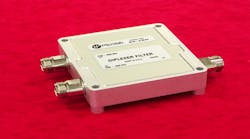The BK-28N line of WiFi and WiMAX combiners from Microlab, a Wireless Telecom Group company, can be used to combine or separate wireless-local-area-network (WLAN) and WiMAX signals in the frequency ranges of 2.4 to 3.8 GHz and 5.15 to 5.85 GHz. Signal loss is only 0.3 dB in the lower-frequency bands and only 0.5 dB in the upper-frequency bands. Based on low-loss stripline technology, these combiners/dividers feature a “Tuned-by-Design” approach that eliminates the need and high cost of adjusting multiple resonant cavities in conventional combiner/divider designs, while also providing 45-dB isolation between the frequency bands. According to Wolfgang Damm, Product Marketing Director of the Wireless Telecom Group, these units are rated for average power levels of 20 W per hand. They exhibit low passive intermodulation (PIM) levels of -150 dBc when evaluated with two 20-W signals.

Sponsored Recommendations
Sponsored Recommendations
UHF to mmWave Cavity Filter Solutions
April 12, 2024
Wideband MMIC Variable Gain Amplifier
April 12, 2024
Request a free Micro 3D Printed sample part
April 11, 2024